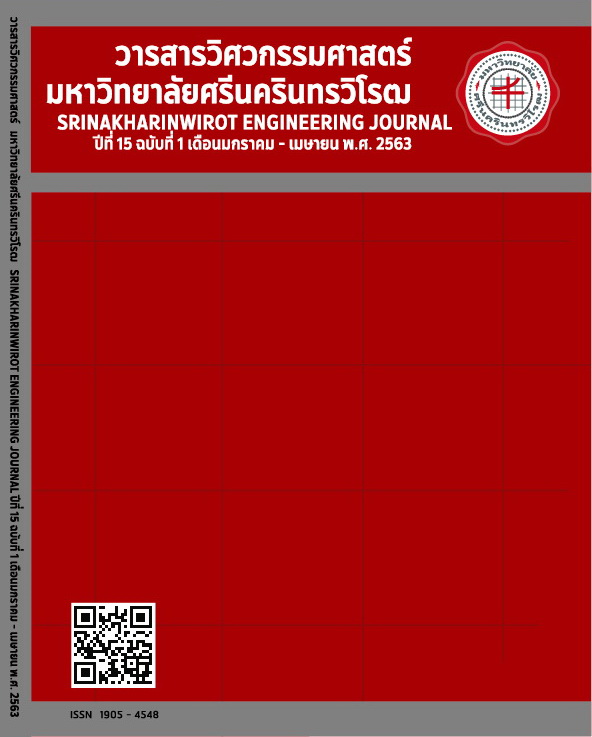A Study of Discharge Heads Affecting the Temperature and Amount of Hot Water Using Mathematical Modeling of a Solar Water Heating System
Main Article Content
Abstract
The aim of this research was to study the discharge heads affecting the temperature and hot water amount in the storage tank of a solar water heating system (SWHS). The designed system consisted of 1.58-m2 flat plate solar collectors, an overhead tank, the T-vent tube and the hot water storage tank. The system simulation was done during 8:00 am–5:00 for 9 h for discharge head of 0.5, 1, 2 and 3 m when solar irradiation was 20 MJ/m2 d. The system could work when the pressure head was slightly more than the discharge head of the system. If the discharge head was increased, the hot water temperature and vapor pressure increased. However, hot water production reduced accordingly. By varying the discharge head, the maximum produced hot water was 89.39 L/d and the maximum thermal efficiency was 40.71% at discharge head 0.5 m, the minimum produced hot water was 37.2 L/d and the minimum thermal efficiency was 19.93% at discharge head 3 m. Furthermore, the maximum water temperature in the storage tank was roughly 70.46°C at discharge head 3 m and the minimum was roughly 64.2°C at discharge head 0.5 m. From this research of the mathematical model gave a reasonable agreement with the experimental results when the difference between the calculated and measured values was less than ± 10%.
Article Details
Copyright belongs to Srinakharinwirot University Engineering Journal
References
DW. Lee, A. Sharma, “Thermal performances of the active and passive water heating systems based on annual operation,” Sol. Energy, vol. 81, no. 2, pp. 207-215, Feb. 2007.
SV. Joshi, RS. Bokil, JK. Nayak, “Test standards for thermosyphon-type solar domestic hot water system: review and experimental evaluation”, Sol. Energy, vol. 78, no. 6, pp. 781-798, Jun. 2005.
JA. Duffie, and WA. Beckman, Solar engineering of thermal processes, 4th ed. New Jersey: John Wiley and Sons, 2013.
AN. Khalifa, “Forced versus natural circulation solar water heaters: A comparative performance study,” Renewable Energy, vol. 14, no. 1-4, pp. 77-82, May-Aug. 1998.
K. Sumathy, “Experimental studies on a solar thermal water pump,” Appl. Therm. Eng, vol. 19, no. 5, pp. 449-459, May 1999.
DJ. Picken, KDR. Seare, F. Goto, “Design and development of a water piston solar powered steam pump,” Sol. Energy, vol. 61, no. 3, pp. 219-227, Sep. 1997.
S. Liengjindathaworn, K. Kirtikara, P. Namprakai, T. Kiatsiriroat, “Parametric studies of a pulsating-steam water pump,” Int. J. Ambient Energy, vol. 23, no. 1, pp. 37-46, Jan. 2002.
N. Roonprasang, P. Namprakai, N. Pratinthong, “Experimental studies of a new solar water heater system using a solar water pump,” Int. J. Energy, vol. 33, no. 4, pp. 639-646, Apr. 2008.
K. Sutthivirode, P. Namprakai, N. Roonprasang, “A new version of a solar water heating system coupled with a solar water pump,” Appl. Energy, vol. 86, no 9, pp. 1423-1430, Sep. 2009.
J. Sitranon, C. Lertsatitthanakorn, P. Namprakai, N. Namprakai, T. Suparos, N. Roonprasang, “Performance Enhancement of Solar Water Heater with a Thermal Water Pump,” J. Energy Eng. (ASCE), vol. 141, no.4, pp. 04014036-1 - 04014036-10, Sep. 2014.


